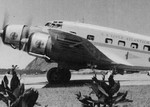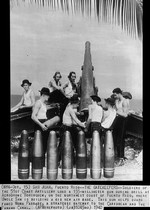Borinquen Field
| Type | 103 Air Base | |
| Historical Name of Location | Aguadilla, Puerto Rico | |
| Coordinates | 18.494444000, -67.129444000 |
Contributor: David Stubblebine
ww2dbaseUnited States Army Air Corps Major George C. Kenney went to Puerto Rico in 1939 to conduct a survey for locations for possible air bases. He looked at 42 locations and determined Punta Borinquen at the northwest corner of the island in the Aguadilla district was the best site for a large-scale air base. In Sep 1939, 3,800 acres of sugar cane were purchased at a cost of $1,215,000. Construction began almost immediately and just two months later, Borinquen Field became home to the 25th Reconnaissance Squadron and their Douglas B-18 Bolo bombers making anti-submarine reconnaissance flights over the approaches to the Caribbean Sea. Built on a large scale from the beginning, Borinquen Field had a 10,000-foot concrete runway (although some of that length may have been added post-war) and plans for five large hangars, each one large enough to house multiple B-17 Fortress bombers.
ww2dbaseInitially, Borinquen Field’s long runways also made it a logical way-point for trans-Atlantic commercial air travel and several airlines landed their flights there. Many of these airlines were technically based in South American countries but they were owned or controlled by German or Italian interests. United States’ neutrality made it hard to stop these flights, even though there were suspicions that as these planes approached cities in Columbia (burning American gasoline acquired at Borinquen Field) they were also conducting reconnaissance on the Panama Canal.
ww2dbaseWith the United States’ entry into World War II, Puerto Rico’s geographic location and Borinquen Field’s ability to handle many large aircraft made the facility superbly versatile. This led to its role expanding in many directions during the build-up to war. In 1937, First Lieutenant Curtis LeMay made a name for himself by successfully navigating a flight of B-17s over water to intercept the Italian ocean liner Rex 600 miles at sea. Therefore, in 1941, Major LeMay was the obvious choice to map out the long, over-water air route to deliver the large number of aircraft from the United States needed in the European/Mediterranean Theater. That route hop-scotched its way south to Brazil, crossed the Atlantic to western Africa, and then on to final destinations either in North Africa or Britain. Known as the “Arabian Knight” flights, Borinquen Field in Puerto Rico became the hub of this operation. Because of the perils in the North Atlantic, the operation expanded well beyond just delivery of aircraft, delivering a large number of troops and even larger amounts of supplies across the ocean. In 1943, Borinquen Field’s activity in the “Arabian Knight” flights amounted to:
- 86,165 troops transiting through (236 troops per day average)
- 10,127 fighter, bomber, cargo/passenger aircraft flights (56 landings & take-offs per day average & not counting patrol aircraft assigned to Borinquen)
- 1,982 aircrafts repaired or serviced (5.5 service completions per day average)
ww2dbaseBy late 1944, Borinquen Field’s location and capacities began taking on a new importance. In the Pacific, the reason to capture the Mariana Islands had always been to bring Japan within range of the B-29 Superfortress bombers; but flying from the Marianas to Tokyo would mean making the entire flight over water. Before moving to the Marianas, the B-29s flew from China where the Army navigators could rely on their usual practice of ground-based landmarks and check-points. Flying from the Marianas would require a different kind of navigation that would have to be refined and practiced. Thus, the plan for the “Gypsy Task Force” was hatched. It was noted that the over-water flight from Borinquen Field in Puerto Rico to Baltimore, Maryland in the United States was almost the exact distance, on the same heading, and at similar latitudes as a flight from Tinian in the Marianas to Tokyo, Japan. Take-offs from Borinquen’s runway almost immediately put the aircraft over the open sea which also resembled the conditions they would face on Tinian, Saipan, and Guam. So, Borinquen Field started filling up with B-29 bombers. Numerous “Gypsy Task Force” practice missions were flown in mock-attacks on Baltimore with return flights to Borinquen Field, some even with mock fighter attacks with P-39 Airacobras acting as the interceptors.
ww2dbaseAs the German military was collapsing in 1945, US planners knew men and materiel from Europe would be needed to fight the Japanese. Thus, the “Arabian Knights” program shifted into reverse. Large numbers of troops and aircraft began moving through Borinquen Field on their way back to the United States for reassignment. When Japan surrendered, the pace slowed down (a little) but the tide continued.
ww2dbaseOnce wartime and post-war activities settled down and the United States Air Force became its own branch, Borinquen Field was renamed Ramey Air Force Base after Brigadier General Howard Knox Ramey who went missing 26 Mar 1943 on a B-17 flight from Port Moresby, New Guinea. During the Cold War, Ramey Air Force Base hosted the very large Convair B-36 Peacemaker bombers, Boeing B-52 Stratofortress bombers, KC-135 Stratotanker aerial refueling aircraft (based on the B-29), and others of the US Strategic Air Command. Ramey Air Force Base closed in 1974 and the facility now serves as the Rafael Hernández Airport, a joint civilian-military (Coast Guard) airport and Puerto Rico’s second largest international airport.
ww2dbaseSources:
United States Air Force
United States Navy
United States National Archives
Ramey Air Force Base Historical Association
Aviation Safety
DiveBuddy.com
Wikipedia
Last Major Update: Sep 2020
Borinquen Field Interactive Map
Photographs
 |  |  |  |
Maps
 |
Borinquen Field Timeline
| 27 Oct 1943 | 4th Tactical Reconnaissance Squadron of 13th Composite Wing of 72nd Observation Group of US Army Air Forces was assigned to Borinquen Field in Puerto Rico. |
| 16 Jul 1944 | Just as anti-submarine aircraft from escort carrier USS Card developed a submerged target southwest of Mona Island by means of sonobuoys, the main bearings of the carrier’s single turbine burned out leaving the ship dead in the water. The aircraft launched two Mark 24 FIDO homing torpedoes without result. Contact was lost and the airborne aircraft were diverted to Borinquen Field, Puerto Rico. |
Please consider supporting us on Patreon. Even $1 per month will go a long way! Thank you. Please help us spread the word: Stay updated with WW2DB: |
Visitor Submitted Comments
22 Apr 2017 05:52:36 PM
I am looking for any items from Borinquen for the museum.
23 Nov 2017 07:51:56 AM
Where is the museum located. My father was stationed at Borinquen Field for a period of time when he served in WWII. I have a souvenir type pillow case cover for a couch pillow from Borinquen Field. I can send you some photos of it but I do not see the ability to attach files on this forum.
16 Sep 2020 06:12:20 PM
Are there any photos of Borinquin field during WWII? It would be interesting to see what it was like to work and live there during that time.
25 Feb 2023 12:18:40 PM
My dad was stationed there during WWII with the Army Air Corps. I have a few photos I would like to donate to a Borinquen historical society. Anyone know of one? thanks
2 Oct 2024 09:12:49 AM
My relative was a staff sergeant in the 417th Bomber Squadron, 25th Bomber Group who was declared missing in action on October 31, 1943. Is there any source of information about specific actions or losses that I might explore to learn more?
All visitor submitted comments are opinions of those making the submissions and do not reflect views of WW2DB.

Aguadilla, Puerto Rico
Latitude-Longitude:
18.4944, -67.1294
- » 1,181 biographies
- » 337 events
- » 45,111 timeline entries
- » 1,247 ships
- » 350 aircraft models
- » 207 vehicle models
- » 376 weapon models
- » 123 historical documents
- » 261 facilities
- » 470 book reviews
- » 28,469 photos
- » 365 maps
Winston Churchill
Please consider supporting us on Patreon. Even $1 a month will go a long way. Thank you!
Or, please support us by purchasing some WW2DB merchandise at TeeSpring, Thank you!
25 Feb 2017 06:52:46 PM
I have a book that was my Uncle Charles Parks. He has passed away and he has no children. The people in the book I do not if anyone might be interested please let know.